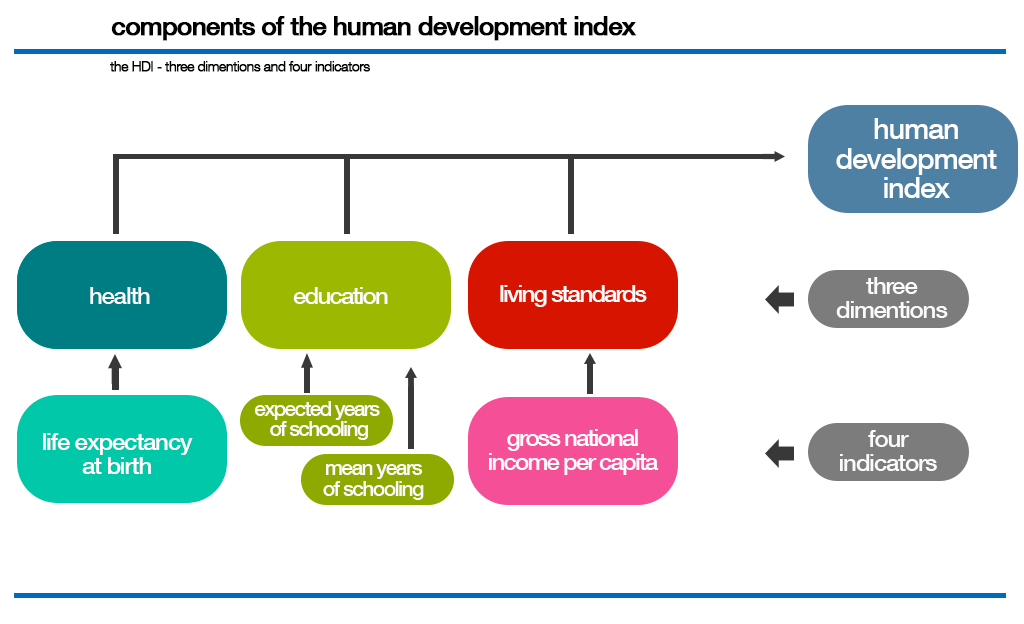
Our species is so important to us that we even attach metrics to it. We have invented what is called the Human Development Index. The HDI was created to emphasize that people and their capabilities should be the ultimate criteria for assessing the development of a country, not economic growth alone. The HDI can also be used to question national policy choices, asking how two countries with the same level of Gross National Income per capita can end up with different human development outcomes. These contrasts can stimulate debate about government policy priorities. In this article, we will take a closer look at The Human Development Index and how this is closely related to the ideals of a Circular Economy.
The Human Development Index (HDI) is a summary measure of average achievement in key dimensions of human development: a long and healthy life, being knowledgeable, and having a decent standard of living. The HDI is the geometric mean of normalized indices for each of the three dimensions. Now let’s think about how this relates to a Circular Economy. A Circular Economy is based on the idea that we as a society may benefit from looking towards a more sustainable approach to how to produce and consume our resources. A major concern one may have in terms of the HDI is pollution. Pollution is a large contributor to overall public health which then affects the ability to live a long and healthy life. Being knowledgeable about the items we produce and consume is an important aspect of the Circular Economy. We would be forced to focus on the sustainability of our actions, thus contributing to higher scores on the Human Development Index. Lastly, we are to question how important our standard of living would be for a Circular Economy to be viable within different nations globally. Do we have the proper means to live in a sustainable fashion and not need to be struggling to maintain a life that is comfortable?
Public Health
The health dimension is assessed by life expectancy at birth, the education dimension is measured by mean of years of schooling for adults aged 25 years and expected years of schooling for children of school entering age. The standard of living dimension is measured by gross national income per capita. The HDI uses the logarithm of income, to reflect the diminishing importance of income with increasing Gross National Income. When it comes to education within the topic of the Circular Economy, not a large amount of people know about what this concept really refers to. People are not truly even aware of the various connections that items such as overproduction and unsustainable mass production cause the environment as well as your own health. In terms of the additive manufacturing industry, it is important to keep these ideals within the mind because we can live well in a world that benefits public health as a whole.

Components of the Human Development Index
The HDI simplifies and captures only part of what human development entails. It does not reflect on inequality, poverty, human security, empowerment, etc. It is important to keep in mind that these aforementioned areas are extremely important within the picture. A Circular Economy would attempt to address these issues within a larger context. It can be deduced that an HDI of a specific country or region will be lower when there are higher levels of inequality and poverty, but I need to do more research before I can make such a statement. It is important to see that if we focus on a Circular Economy model within Additive Manufacturing, we may gain various benefits. This includes more efficient usage of materials, longer and healthier lives, as well as a better standard of living for the public as a whole.
Subscribe to Our Email Newsletter
Stay up-to-date on all the latest news from the 3D printing industry and receive information and offers from third party vendors.
You May Also Like
Air Force Awards Fortius Metals $1.25M to Qualify 3D Printing Wire for Hypersonic Applications
AFWERX, part of the US Air Force Research Laboratory (AFRL), awarded a Direct-to-Phase II Small Business Innovation Research (SBIR) contract worth $1.25 million to Colorado’s Fortius Metals, to accelerate qualification...
US Air Force Awards JuggerBot $4M for Large-format Hybrid 3D Printing
Large-format 3D printer manufacturer JuggerBot has received a $4 million grant to develop a large format 3D printer, courtesy of the Under Secretary of Defense, Research and Engineering Manufacturing Technology...
Where Have All AM’s Unicorns Gone?
In the rapidly evolving world of 3D printing, startups valued at over a billion dollars, known as unicorns, once seemed as fantastical as the mythical creatures themselves. While a few...
How My Childhood Fascination with Planes Led to Investing in 3D Printing
My fascination with aerospace started young, and I started studying planes–identifying them in the sky and learning everything I could about how they work. Fast forward to my first week...
































